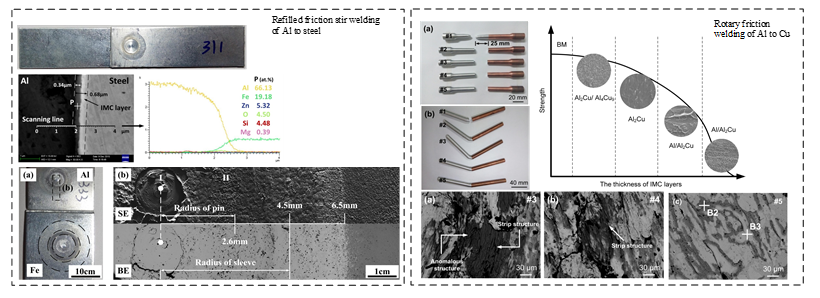Video Article Open Access
Solid-state Welding Process and Mechanism of Dissimilar Metallic Materials
Honggang Dong*, Su Chen, Longwei Pan, Pengxiao Wang, Peng Li, Lianzhen Yu
School of Materials Science and Engineering, Dalian University of Technology, Dalian, 116024, China
Vid. Proc. Adv. Mater., Volume 3, Article ID 2208335 (2022)
DOI: 10.5185/vpoam.2022.08335
Publication Date (Web): 12 Dec 2022
Copyright © IAAM
Graphical Abstract

Abstract
Light-weight alloys have been applied in automotive, aerospace, rail transit, and shipbuilding industries to reduce structure weight for energy conservation and emission reduction. As one of the most widely used light-weight alloys, aluminium alloy has been designed to replace steel and/or copper in many structures. So, joining aluminium alloy to steel and/or copper is inevitable for weight reduction and combining the advantages of high specific strength and good resistance to corrosion. However, joining aluminium to steel and/or copper is still a great challenge because of the large differences in thermo-physical properties between the two materials and especially because of the easy formation of brittle intermetallic compounds at elevated temperatures. Dissimilar materials lap joining of aluminium alloy to steel sheets was investigated with refilled friction stir spot welding in this work. The microstructure, mechanical properties, and fracture mode of Al/steel joints were analysed. The maximum tensile/shear fracture load of joints between aluminium alloy and uncoated steel reached around 3800 N. While with galvanized steel, the maximum tensile/shear fracture load of joints reached 4500 N. The maximum tensile/shear fracture load of Al/uncoated steel and Al/galvanized steel joints occurred when the sleeve plunging depth was larger than the thickness of the aluminium alloy sheet. Zinc and oxygen rich layers were observed in the interface on Al side, and ZnO phase was detected on the fractured surface of both aluminium alloy and steel sides. The samples during tensile/shear test failed mainly through shear brittle fracture with features of cleavage and intergranular fracture feature. The spot weld can be distinguished as pin-refilled zone and sleeve-plunging zone from the distribution of zinc. When the sleeve plunged into the steel substrate, metallurgical bonding and mechanical bonding occurred at the interface, which could substantially improve the mechanical properties of spot weld. Rotary friction welding of commercial pure aluminium to pure copper was also investigated. The mechanical properties and electric conductivity of the welded joint were improved with post-weld heat treatment. The resistivity of Al/Cu friction welded joint after heat treatment at 100oC/2h was the lowest, and its mechanical properties were also the best. Heat treatment at lower temperatures can release the residual stress of Al/Cu friction welded joint, and reduce the resistivity. The resistivity gradually increased from the center to the edge of joint. When the heat treatment temperature rose, the interface thickened, and the resistivity of joint increased. When the heat treatment temperature reached 400oC, the thickness of intermetallic compounds layer of joint sharply increased. Micro cracks occur in the center, which enhances the resistivity remarkably.
Keywords
Dissimilar materials joining; microstructure; mechanical property.
Acknowledgement
This work was financially supported by the National Natural Science Foundation of China (Nos. 51674060, 51374048 and 50904012), Fundamental Research Funds for the Central Universities (DUT13ZD209) and the Science and Technology Foundation of Liaoning, China (No. 201301002).
References
- H. Dong, S. Chen, Y. Song, et al., Materials & Design, 2016, 94, 457.
- H. Dong, P. Wang, X. Hao, et al., Materials Letters, 2018, 228, 407.
- L. Pan, P. Li, X. Hao, et al., Journal of Materials Processing Technology, 2018, 255, 308.
Biography
Honggang Dong has been working in the community of Materials Science and Engineering for nearly twenty years. He obtained the Bachelor, Master and Ph.D. Degrees from Harbin Institute of Technology in 1998, 2000 and 2004, respectively. Then he joined Dalian University of Technology as a faculty in September of 2004. From December 2005 to December 2007, he worked as a Research Associate in Department of Materials Science and Engineering, University of Wisconsin-Madison, USA. He returned to Dalian University of Technology in January 2008, and was promoted to full professor in 2013. From 2014, he was appointed as Deputy Dean of School of Materials Science and Engineering, and from 2019 as Deputy Director of Key Laboratory of Materials Modification by Laser, Ion and Electron Beams of Ministry of Education.
His research interests cover dissimilar materials joining technology and metallurgy, composition design of welding materials, and numerical simulation of welding processes. He achieved Youth Science and Technology Achievement Award by Chinese Mechanical Engineering Society in 2015 and First Prize of Liaoning Province Science and Technology Progress Award in 2018. He has published more than 150 academical papers and 5 licensed patents. He has supervised more than 60 graduate students. Now he is Associate Editor of the journal Welding International, and Editorial Board Member of journals Transactions of the China Welding Institution, China Welding and Welding Technology.
Video Proceedings of Advanced Materials

Upcoming Congress



